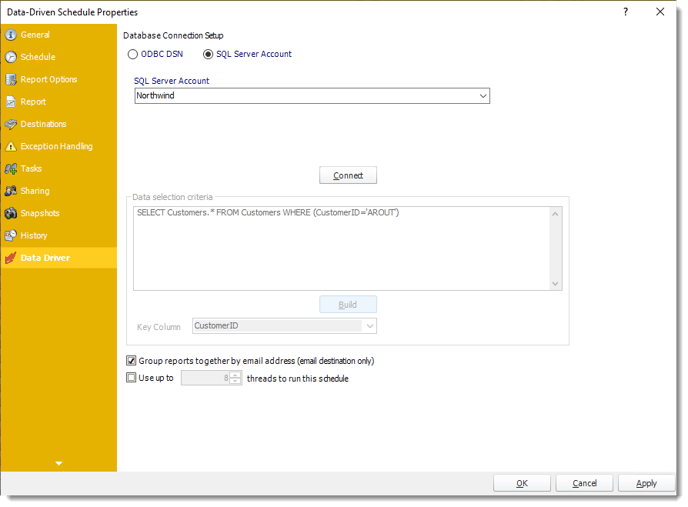How do I use Data-Driven Schedules for Paginated Reports on Premise or SSRS reports in PBRS?
A data-driven schedule allows you to drive all variables of your reporting requirements (parameters, destinations, output formats, etc.) from database tables and queries at run time. Burst your reports out to multiple formats & recipients.
This article applies to:
- Power BI Paginated Reports (On Premise - Power BI Report Server)
- Microsoft SSRS Reports (On Premise - SQL Server Reporting Services)
Data-Driven Schedules for Paginated Reports on Premise or SSRS Reports
A data-driven schedule allows you to drive all variables of your reporting requirements (parameters, destinations, output formats, etc.) from database tables and queries at run time. You can also use static text and default values should you wish. You can use Data-Driven schedules for a number of scenarios. Use a data-driven schedule for bursting reports based on parameter values to specific formats like PDF, Excel and so on.
Here are some examples:
- Distribute a report to a fluctuating list of recipients. For example, you can distribute a report throughout a large organization where recipients vary from one month to the next, or use other criteria that determines group membership from an existing set of users. E.g. select * from mytable where firstname = ‘john’ will generate the report and distribute only for records where the recipient’s first name is John.
- Filter the report output using report parameter values that are retrieved at run time. For example, the parameter value returned from the table for Last Name will be “Doe” for John Doe and “Smith” for John Smith.
- Determine the delivery type and report format dynamically at run time. For example, John Smith gets the report as a PDF file by email with a customized email body and John Doe gets the report as an excel spreadsheet by FTP uploaded to his webserver.
The following simple example will illustrate the process of creating a Data-Driven Schedule.
Scenario: You have a report which has a large number of parameter and destination combinations. Representing the combinations in a table may look something like the example below (Yellow = parameters)

- You need to have the report run once for each record. The parameter values entered in the table above should populate the parameters in the report and the report should be delivered to the destinations shown in the table.
- Please note that with the above data when the schedule runs, the following will occur:
- John Doe will receive only one email for the reports from sectors 1 and 3. He will also get the reports from sectors 2, 3 and 34 delivered to his reports disk location.
- Peter Crimble will have his report printed on the Printer he specified.
- Jorge Minola will have a copy of his report sent to John Doe to the disk location he specified and a copy uploaded to his FTP server and folder.
- Anil Maharaja will receive an email as requested.
- John Wu will have his report delivered to his email and FTP server as requested.
Note that as the data changes in the database to reflect the requirements, the reports will be delivered as necessary without requiring any changes to the schedule in PBRS.
Using a Data Driven schedule PBRS will reel through the database table and generate and deliver a report for each record using the information provided.
The data driver allows for bursting reports to different formats and different destinations as well as defining other more traditional values like parameters.
How do I create Data-Driven Schedule for Paginated Reports on Premise or SSRS Reports?
Step 1 - Navigate to Data-Driven and select For SSRS or Paginated Reports.

Step 2 - Build a Data Driver

Building a Data Driver Wizard
- The Data Driver is where you set up the source for data for your data-driven reports. If your data source or data selection criteria changes this is where you will need to make any required changes.
- ODBC Datasource Name: Check this option to use ODBC DSN. Drop down and select a DSN.
We strongly recommend System DSNs so that the DSN is visible to PBRS even when the user associated with the DSN is logged off.
All communication to databases (including Access databases) is done through ODBC, so you must setup a system DSN to the database before you can use this facility.
When setting up DSNs we recommend (if possible) that you use Windows Authentication (Trusted Connection). This ensures that your username and password are not required to be stored in PBRS (more secure) and overcomes a large number of security restrictions which Windows places on DSNs. When using Windows Authentication, make sure that the PBRS NT service user (or background application service user) has full rights to the database otherwise, though you will connect when you are logged in, automated scheduling will fail if the Service user has not got rights to the database.
When setting up a DSN to a SQL server, you must ensure that the "Default Database" setting is set to the database you are connecting to (Windows defaults this to "Master").
- UserID: Enter the User ID PBRS should use to log on to the database.
- Password: Enter the password associated with the above user.
- SQL Server Account: Check this option to use your SQL Server Account.
You must add the SQL Server Account in Integrations.
- Connect: Click Connect to connect to the Database.
- Select the table from the database that holds the required data. You can refine your selection query by using the simple or advanced tabs.
Step 3 - Click Parse to determine if the query entered brings back the required information.
- For more information of "Get Values From Database" interface, click here.
Step 5 - Click OK to save the query.
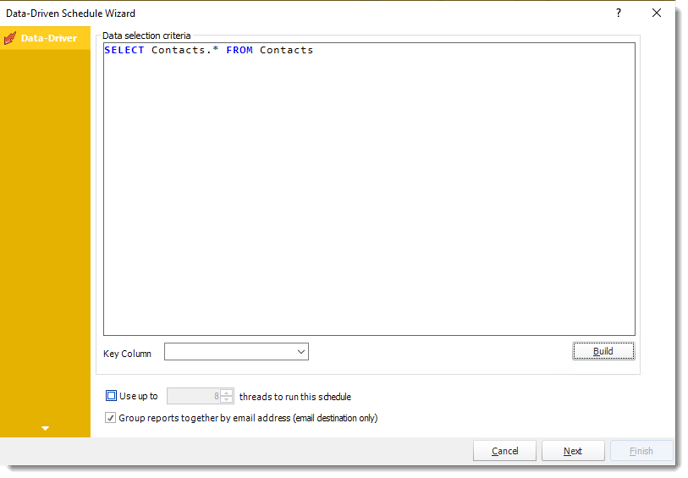
- Click Build to specify the data selection criteria. This will return you to the Build Data Driver tool.
- Key Column: Select the key column for the data that is returned for the reports. The information that drives the schedule is required to have a key column so that each row in the table is uniquely identified by the value in this column. The key column is there as an identifier which is used to troubleshoot in cases where there is a problem with one of the records.
- Use up to 'x' threads to run this schedule: Check this option to allow x amount of threads to be exported simultaneously.
- Group reports by email address: You can instruct PBRS to group reports that are sent to the same email address. Please note that enabling this option disables the ability to embed the reports in the email body for email destinations.
Step 6 - Click Next to continue to the next wizard section.
General Wizard
Step 7 - Complete the General Section of the Wizard.
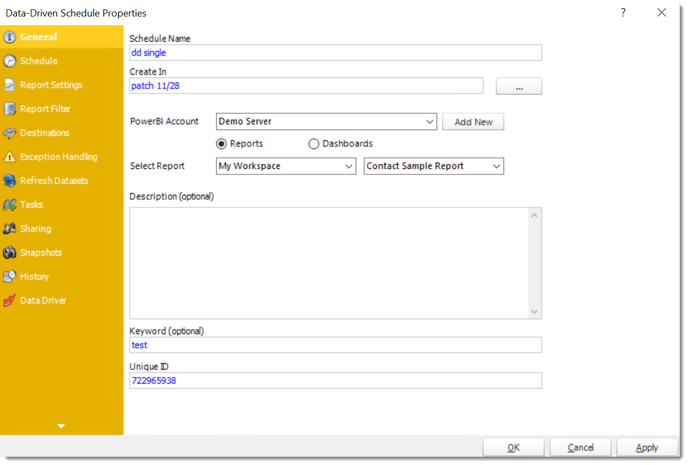
- Create in: The PBRS folder where the schedule is stored.
- Use SSRS Account: Select the SSRS Account where your report server is located, and then click on (...) button next in Report Location.

Hint: SQL Azure Reporting Services- when writing your report, make sure you have enabled Forms Authentication. You should use the 2010 .asmx address for your reporting service URL.
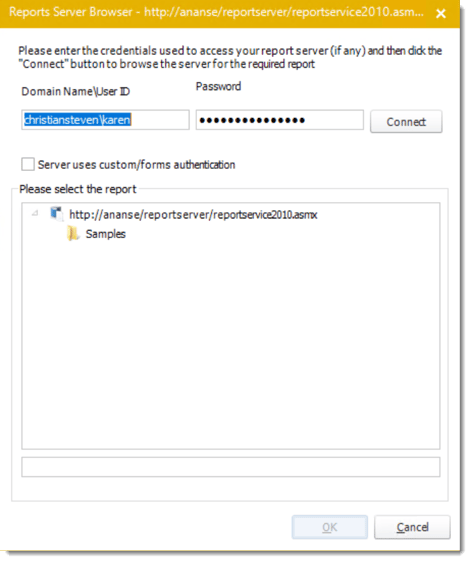
- Service URL: Uncheck 'Use SSRS Account' checkbox, to enter the address of your reporting services server.
- Report Location: Browse through the report server browser to select the desired report. Authenticate to the reports server if necessary.
- Schedule Name: The name of the schedule.
- Description: A short description to help other users identify exactly what this schedule is and what it is expected to do.
- Keyword (optional): Enter some keywords which can be used later by Smart Folders to identify this schedule.
Step 8 - Click Next to continue to the next wizard section.
Schedule Wizard
Step 9 - In this section, you will decide when the report will execute. There are a variety of options.
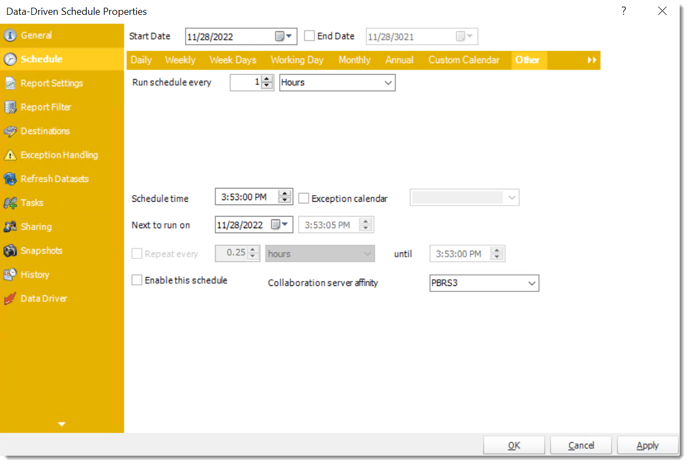
- Daily: Run a report every day or at a frequency of days.
- Sub options: Repeat every X Days.
Example: Run the schedule every 3 days.

- Weekly: Run a report on a weekly time frame.
- Sub options: Repeat every X weeks.
Example: Run the schedule every 2 Weeks.
- On: Select the specific days of the week the schedule will run. If only once a week, select only the day of the week it will run.
Example: Run every Monday, Wednesday, and Friday.

- Week Days: Run the schedule Monday through Friday.

- Working Day: Run the schedule starting on a specific day of the month. Indicate which day of the month the schedule will run. E.G. run the schedule on the 4th working day of the month.

- Monthly: Run the schedule on a monthly time frame.
- Use the following options: Checking this box will enable you to select frequency options such as the “last Thursday of the month.” Also you can include or exclude specific months from the schedule.

- Annual: Run the schedule every year at a specified time.

- Custom Calendar: Select the custom Calendar you wish to use. You can create a new custom calendar from the menu as well. Please see Custom Calendars for more information.

- Other: Other scheduling options.
- Run Schedule every X Minutes, hours, days, weeks, months, years.

- None: No scheduling is required for this item.

- Start Date: Enter the desired starting date for the schedule. This section can be the current date (providing schedule time has not already passed) or a date in the future.
- End Date: If the schedule is due to end after a certain date enter that here. If the schedule is to run indefinitely, then leave it blank.
- Schedule time: On the Next Run date, the package will run at this time.
- Exception Calendar: Choose a calendar that will instruct the schedule to NOT run on those specified days. Please see Custom Calendars for more information.
- Next to run on: The package will next run on this date.
- Repeat Every: Rerun the package every x minutes from the scheduled time until your specified time.
For example, you can set up a daily package to run every day at 8 am, and to run every hour until 5 pm.
- Until: After this date, there will be no automated scheduling of this package.
- Enable this Schedule: Uncheck this option to Disable the package. Disabled packages are not deleted, but they do not execute automatically. You can re-start the automatic scheduling at a later date by checking this option again. Or right-clicking this schedule from the main screen and selecting Enable.
Step 10 - Click Next to continue to the next wizard section.
Datasources Wizard
Step 11 - In this section you will authenticate to the database what the report runs against, set snapshots, and other options.
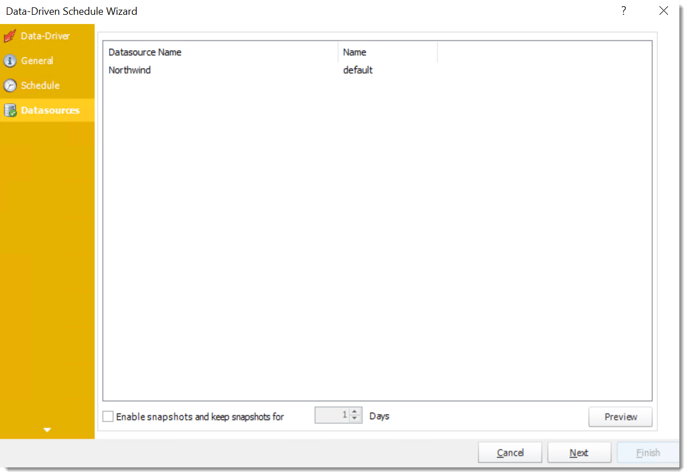
- Login Required: Set the authentication information for the report.
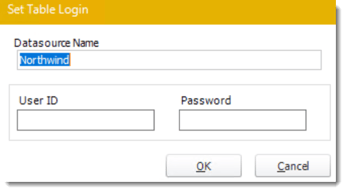
- Enable Snapshots and keep snapshot for X Days: Save a Picture of the report as it is produced. Choose the amount of time will be stored in the system before deletion.
- Preview: View the report prior to execution.
Step 12 - Click Next to continue to the next wizard section.
Report Wizard
Step 13 - In this section, you will determine the parameters for your report (if any). If your report has no parameters, you may skip this section by clicking next.
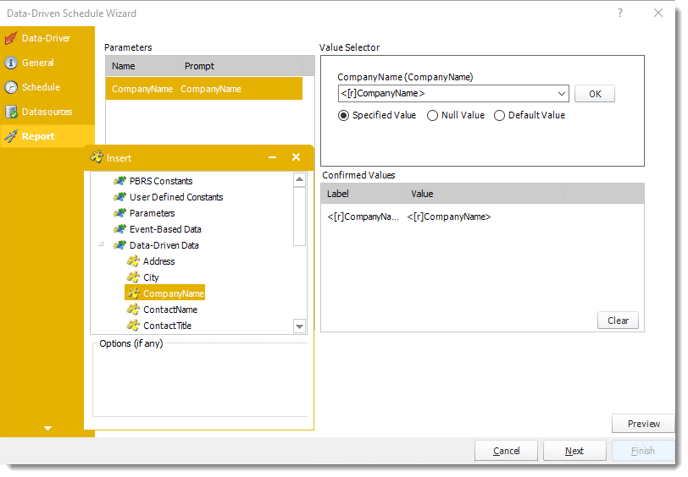
- Drag and drop Data-Driven Inserts into the Value Selector textbox.
- There are 3 requirements in order for PBRS to detect your SSRS Report parameters and their parameter values:
- The parameter must be in use in the report.
- The parameter must be visible.
- The parameter must be set to be prompted at run time.
- If these three requirements are achieved, you should see the parameters in your report listed in this screen.
- For each parameter, select from the drop-down list the value the report must use. In a single schedule, only one parameter value can be run at a time per parameter. You can type a value into the field, or drag and drop an "insert".
- PBRS can handle SSRS Reports with Cascading parameters, or reports where you can select multiple parameter values.
- Specified Value: Select the value you want in your report.
- Null Value: Set no value for this parameter.
- Default Value: It will select the default value.
- All Values (at run time): Any new values will automatically will be included at run time.
Destination Wizard
Step 14 - In this section, you will decide where your schedule will be delivered. The list in the center will display the list of destinations you have added to the schedule. You can organize the various destinations’ order by clicking on the green up and down arrows.
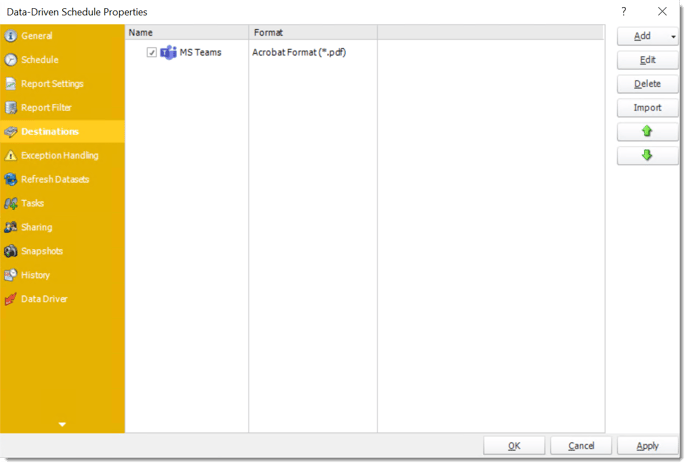
-
- For more information of adding destinations, click here.
- For more information about Output Formats, click here.
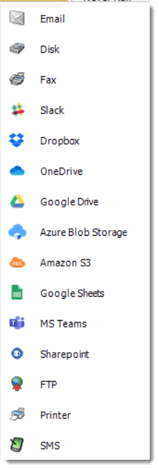
- Edit: Select a destination and click to edit it's properties. Or simply double-click on the destination.
- Delete: Select a destination and click this button to delete it.
- Import: Click here to import from the list of default destinations.
Customizing the Destination
With the Data Driven Schedule, you can determine the delivery method of your report based on your data. In your table, specify the delivery method by creating a column for each delivery type (FTP, SharePoint, Email etc.). For each record specify their email, fax number, and so on.

Tip: For email destinations, simply add a semicolon after an email address to send the same instance of the report to another email address.
- Data driving the Report's Distribution
- As mentioned above, PBRS will pull delivery data from your database.
- In this example, we will be using email addresses found in the table.
- With Data Driven inserts, simply drag and drop the field that indicates your desired destination (email in this case).

- Now PBRS will deliver a unique report based base on a corresponding email address.
Customize Recipient Messaging
- You can also customize the messaging the recipient receives. Using Data Driven Inserts, PBRS will automatically pull data from your table and use it to customize the subject, body or report format.
- Simply drag and drop fields from your table to the desired position.
For example, to customize an email greeting, type the greeting, and add the recipient's name as shown above.
Step 16 - Click Next to continue to the next wizard section.
Exception Handling
Step 17 - In this section you will determine Schedule Retries should an error occur. In addition what action should be taken if a Report Export is Blank or if the Report Export Fails.
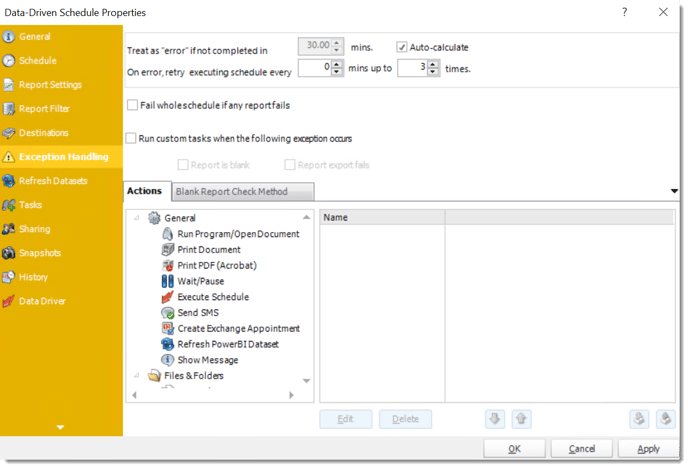
- Treat as “error” if not completed in X minutes: If a report takes longer than the specified amount of time to run, this option will treat the schedule as an error and follow the appropriate action. The “Auto-calculate” option instructs PBRS to automatically determine how long a schedule should take to run the report. If it takes longer than the calculated amount of time, then it is an error.
If manually determining the error timing, please double check the run time of the report in order to get the correct time estimate.
- On error, retry executing schedule every: If set to 0, PBRS will deem the schedule as "Failed" the first time it encounters an error. The schedule will not run again until its next scheduled time. Change the value to tell PBRS how many times you want it to retry running the report before declaring it as "Failed."
- Check if the Report is Blank: If a report is blank because it genuinely returned no data, recipients can misconstrue this as an error with the scheduler. This option allows you to identify genuine empty reports and instruct PBRS on what to do with them.
- Ignore the report and subsequent tasks: If the report is blank, do not send the report. The report will not be delivered to the destination. No custom tasks will be run.
Method
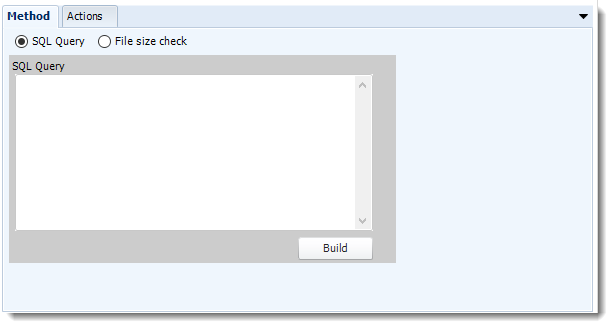
- Select the Method that will determine whether a report is blank.
- SQL Query: Select this option to use a user made query that will determine if the report is blank. If the query returns no results, the report is blank.
- Click Build.
- Get values from a database window will appear. For more information about Get values from database, click here.
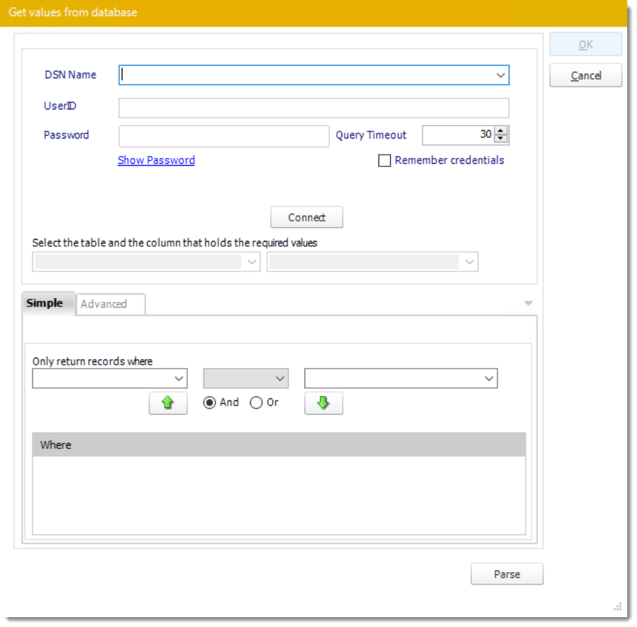
- File size check: Assume reports is blank if size is under "X" bytes.

Actions
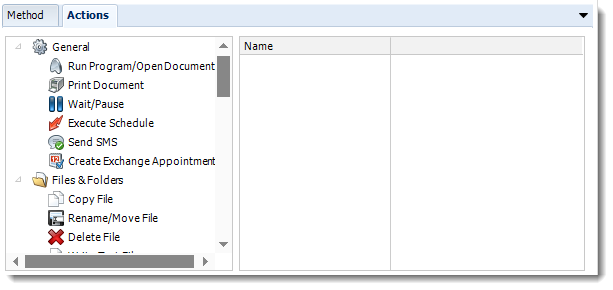
- Select an action from the task list. This task will be executed in the event that a schedule is blank.
- For more information about tasks, click here.
Tip: You can send a notification if a report is considered blank instead of sending the report. Simply select “check if a report is blank” then select “Ignore the report.” In the actions tab, select “Send Email” from the list. Compose your email and save.
Step 18 - Click Next to continue to the next wizard section.
Custom Tasks
Step 19 - In the section you have the option of setting up Custom Tasks. Custom tasks are business process automation tools that can be auto triggered before or after a report runs. Simply navigate to the task you would like to set up and drag & drop to the right hand side of the screen. This will automatically open the Configuration screen for the selected task.
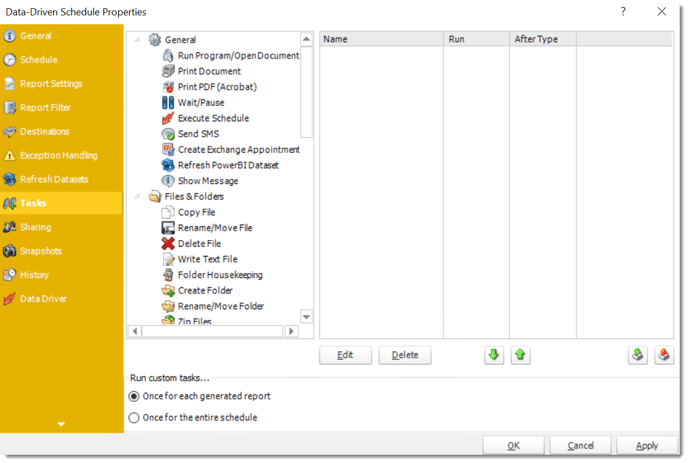
- For more information on Custom Tasks, click here.
Data-Driven Schedule Context Menu
Right-Click on a schedule to see the following actions:
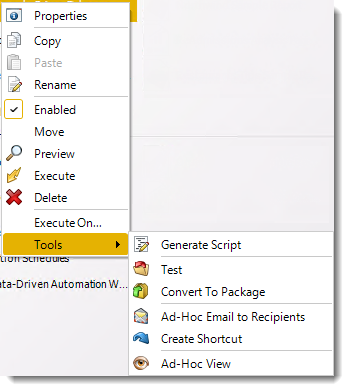
- Properties: Edit the schedule from here. Or you can just double click on the schedule.
- Copy: Use this to copy the schedule. Right-click in the "white space" of the folder you wish to copy it to and select the Paste button.
- Rename: Rename the package.
- Enabled: Schedules are enabled when there is a check icon beside this option. To stop a schedule from running, or to "pause" it for a while, select this option to remove the check icon. Disabled schedules will not run until they are enabled again.
- Move: Use this option to move the report into an existing package.
- Preview: Preview the report before execution.
- Execute: This button will execute the schedule immediately. Note that the next run date and time is not moved on as a result of a manual execution. They only move on if the schedule is run automatically by one of the schedulers.
- Delete: Selecting this option will delete the schedule.
- Execute On: Use to option to execute the schedule to another collaboration server.
- Test: Use this option to test the schedule and export it to selected "test" destinations.
- Convert To Package: This button will move this report into a package. The package will have the name of the single schedule report.
- Ad-Hoc Email to Recipients: Select this option to send an ad-hoc email to all recipients of this package. You can use this to alert recipients to a planned system outage, or any other useful information.
- Create Shortcut: Use this option to create a shortcut you can save in any location on your PC. Execute the shortcut to execute the schedule in PBRS.
- Ad-Hoc View: This button allows you to preview the report.
Data-Driven Schedules Properties
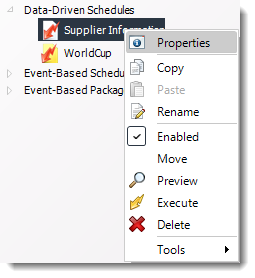
- To access your schedule properties, right-click on a schedule and select properties.
- Similar to the schedule wizard, you adjust settings to your schedule such as timing, error handling, or custom tasks.
- General
You can view the Schedule Unique ID in the General Wizard.

- Schedule

- Report Options
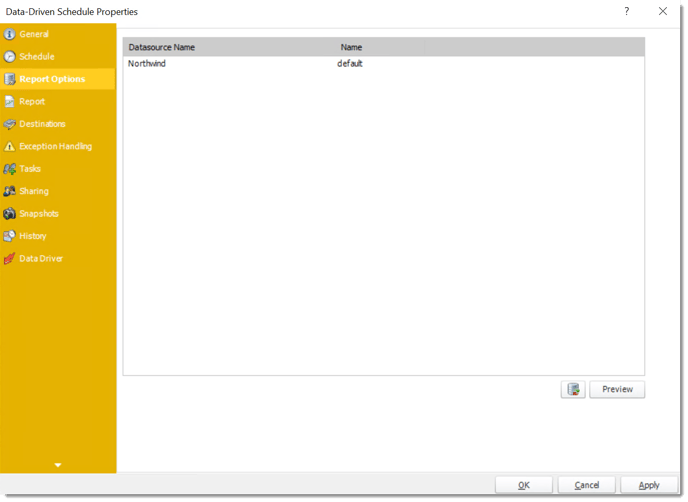
- Report

- Destinations

- Exception Handling

- Tasks

- Sharing: Here you can share this schedule with multiple users.
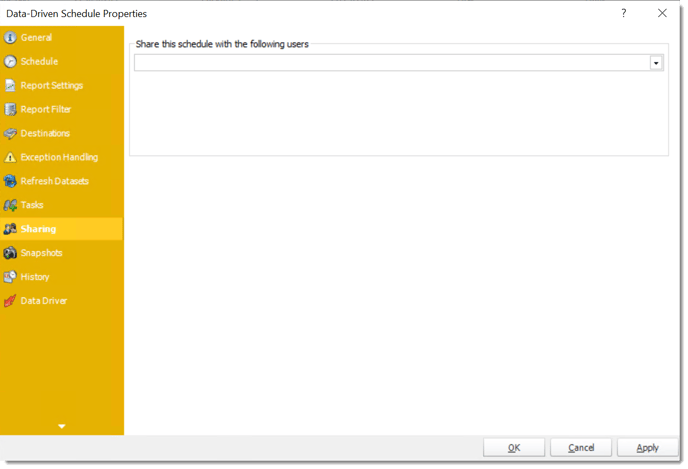
- Snapshots: A snapshot is a copy of each report a schedule or a package generates. Keeping snapshots enables you to resend past reports without generating them afresh - especially if the data has changed in the meantime.
- Simply select the number of days to keep the snapshots.
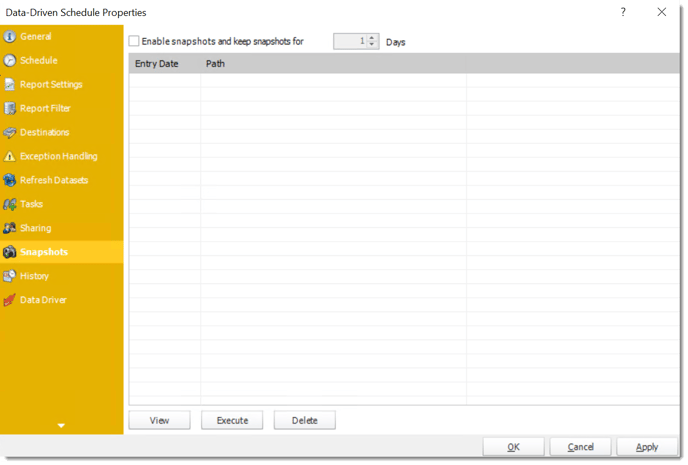
- History: Review the schedule's history. Successes, failures, and other data is located here.

- Data Driver
